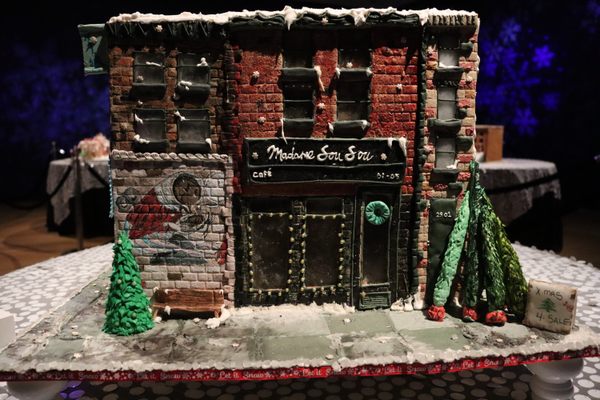What Is Gingerbread? The Answer Is Complicated
Historically, gingerbread didn’t always include ginger.
THIS ARTICLE IS ADAPTED FROM THE DECEMBER 16, 2023, EDITION OF GASTRO OBSCURA’S FAVORITE THINGS NEWSLETTER. YOU CAN SIGN UP HERE.
On the back of my left hand, I have a silvery, 20-year-old scar. The size and shape of a long grain of rice, it’s the result of the time that my mother and I attempted to make a gingerbread house far above our skill level.
Along with blueprints for gingerbread castles and football stadiums, the elegant cookbook we used contained a recipe for “Sticky Sugar Glue” to cement together our creation. Sticky Sugar Glue turned out to be an unmanageable vat of boiling sugar paste. After a drop of this magma seriously burned my hand, we dumped out the pot and used a hot glue gun instead.

Decorated gingerbread is an age-old custom, though houses are not. That’s according to Sam Bilton, the author of First Catch Your Gingerbread, which traces the treat’s history in England. “The idea of highly decorated gingerbread has been around a long time. I didn’t find much evidence to suggest that the houses have been around quite as long,” she says.
Gingerbread’s main feature is its spices, many of which are native to Asia. Their rarity in Europe led to their being used for special occasions, such as banquets and festivals. The earliest English recipes date to the 15th century, but those would be unrecognizable as gingerbread today. In the early cookbook Forme of Cury, “gyngebred” is made of crushed, dried breadcrumbs, laced with spice and held together with honey. What’s remarkable about this recipe is that it contains no ginger at all.
Scholars have speculated for years that this was a mistake—that a careless scribe left out the essential ingredient. But Bilton disagrees, having made the recipe for her book. The recipe calls for saffron, cinnamon, and pepper. “When you combine those spices, it tastes like gingerbread,” she says. Perhaps ginger had been impossible to get, and a clever cook improvised with what they had on hand.
This led me to think about the definition of gingerbread itself. You’d think that gingerless gingerbread would be impossible, like leaving the chocolate chips out of chocolate-chip cookies. But gingerbread is just an umbrella term for a whole world of sweets. “The Oxford Companion to Food defines it as ‘a product that is always spiced, and normally with ginger, but which varies considerably in shape and texture,’” Bilton says.
As a big fan of spiced baked goods, I’m grateful that gingerbread’s family tree is so large and diverse. Around the world, and especially this time of year, people are eating their very own versions. Here are a few fascinating examples.
Cochinitos de Piloncillo

Mexico’s cochinitos (also called marranitos or puerquitos) are an intriguing example of cultural exchange. For centuries, bakers in England sold gingerbread at fairs and festivals. The gingerbread was often pig-shaped.
One theory as to how these spiced, slightly sweet, bready pigs became a pan dulce specialty was that during the First World War, the English arriving in Mexico for petroleum extraction brought along their custom of gingerbread pigs. Modern cochinitos, however, are spiced with cinnamon and star anise instead of ginger, and sweetened with the raw sugar known as piloncillo. Unlike many other gingerbread types, cochinitos are available year-round.
Parkin
“Even with how small Britain is, we have regional variations in our own country,” says Bilton. “In the north of England, they eat something called parkin. It’s particularly popular around the 5th of November, which is Bonfire Night.”
Parkin, which Bilton notes is “neither a cake nor a biscuit, but an entirely separate thing,” is made with oats and treacle, a dark, molasses-like syrup. Ginger is included, along with other warming spices. Bilton says that it’s especially good when it’s allowed to sit for a few weeks for the flavors to mature.
Pepernoten

“The Dutch have so many gingerbreads,” says my coworker Diana Hubbell, who spent part of her childhood in the Netherlands. Pepernoten are one fascinating variety. Small, crunchy, nut-shaped, and nut-colored, these cookies are flavored with not only ginger but also white pepper, cinnamon, cloves, coriander, and aniseed.
Saint Nicholas’s Eve (December 5) is prime time for pepernoten. At parades, a figure dressed as the OG Santa Claus, Sinterklaas, will pass them out to children. The next morning, children awake to find the wooden shoes they placed by the fireplace filled with pepernoten and other treats.
Printen
Germany is another country with a proud tradition of gingerbread. One particularly interesting variety, printen, hail from the city of Aachen, and by law they can be made only in the area. The town is home to the Klein Printen Bakery, which doubles as a museum of the cookie’s history.
A few things make Aachener printen unique. While they contain ginger and other standard spices, they also use beet syrup instead of honey or sugar. This dates back to the Napoleonic War, when the region was cut off from supplies and bakers had to get creative. The beet syrup makes the cookies fairly hard, but they’re traditionally stored in a box right after baking so that condensation will soften them. While Aachener printen come in many shapes and flavors, the Klein bakery still uses elaborate wooden molds to give some of their cookies detailed, fantastical designs.
Gastro Obscura covers the world’s most wondrous food and drink.
Sign up for our regular newsletter.


























Follow us on Twitter to get the latest on the world's hidden wonders.
Like us on Facebook to get the latest on the world's hidden wonders.
Follow us on Twitter Like us on Facebook